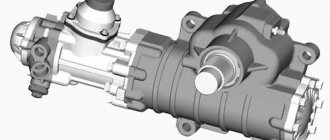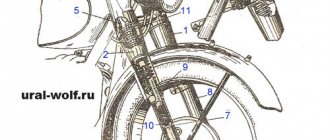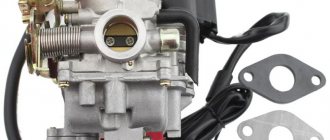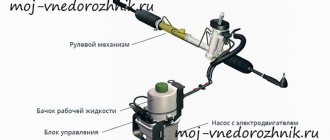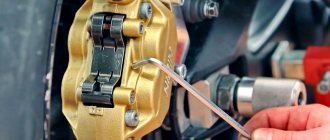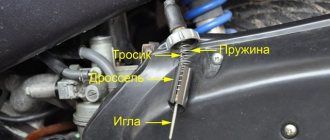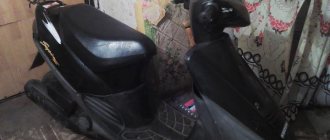Motorists know how much nerves are wasted when problems with power steering occur. The steering wheel behaves strangely and turns much more difficult at idle or low speeds. A whistling sound is heard from the pump bearing. Leakage of working fluid onto the engine or onto the road at the location of the unit. The rotation of the steering shaft is accompanied by extraneous sounds.
These inconveniences can affect not only the driver’s nervous health, but also driving safety. What to do if symptoms of a pump malfunction appear? How to replace this power steering part? Is it possible and how to carry out repair work yourself? We'll tell you more about everything below.
Symptoms of power steering pump malfunctions
Although the vane and vane pumps installed in the power steering design do not break down so often, we will still consider what the signs are and how to extend the service life of the pump.
You can extend the service life by the following actions:
- Change the fluid on time. Few people change the oil in their hydraulic booster, but it becomes old and loses its properties. Therefore, it is necessary to do this.
- Monitor the fluid level in the power steering reservoir.
- Try not to turn the steering wheel when the internal combustion engine is not running. If the fluid in the power steering system does not move, the pump overheats. The oil does not move if you turn it many times with the engine off.
- When changing the oil, make sure that no debris gets in.
If you follow the operating rules, the power steering will last a long time. Check the oil level periodically. When adding fluid, add only the same brand.
If you notice signs of problems with the power steering system, you should not drive fast or long distances until the causes are eliminated.
Signs of problems with power steering:
- If you have difficulty turning the steering wheel at idle and at low speeds. At high speeds there are no problems with turning the steering wheel.
- If you find a fluid leak from the power steering system.
- If you hear extraneous sounds while turning the steering wheel.
- If you hear a whistling or humming noise from the bearing. If the bearing is removed, there will be play when the pulley rolls.
Possible faults
Design of the power steering system
Why did the power steering stop working at idle and began to leak, how to independently check and disassemble your incorrectly working steering mechanism, what to do if the steering wheel turns poorly and tightly?
First of all, let's look at the main faults of the power steering:
- The first sign of a power steering malfunction is jolts when driving - as a rule, this indicates that the power steering belt is poorly tensioned. If it is necessary to exert force to turn the steering wheel, it is necessary to diagnose this element, and also check for the presence of consumable fluid. Perhaps a tight steering wheel indicates that an air lock has formed in the system. Also, if such a malfunction occurs in the power steering, you can diagnose the oil pump.
- Power steering diagnostics includes checking the functionality of the shafts, if the pump pulley can be unscrewed without any problems. Sometimes it happens that the device has a poor connection of pipes.
- Another sign of a faulty power steering is a noise in the steering wheel. Perhaps the problem lies in poor installation of the tie rod ends, or the fastening on the elements is simply loose.
- Adjustment and repair of the power steering may be required if, after turning, the wheels return to their original state with difficulty. In this case, if the power steering is operating quite normally, the problem is usually poor flow control valve alignment or loose ball joints.
- Another reason why it is necessary to check and repair the power steering is the dysfunction of the pump flow control valve. This is usually due to the pump pressure being too low.
Power steering: what is it and what does it consist of?
Hydraulic power steering is a part of the steering mechanism that makes it easier to control the car when turning or hitting uneven roads. The hydraulic booster reduces the effort the driver puts on the steering wheel while driving. If you have a working hydraulic booster, it is much more comfortable for the driver to drive, there is less strain on his hands, and the parking process is easier.
We recommend: Do-it-yourself auto electricians: repairs and practical recommendations from specialists
Power steering components:
- Pump . The main part of the system. The belt connecting the booster to the crankshaft drives the pump, so the whole mechanism works when turning;
- Distributor . A high-pressure pump supplies oil to a distributor that is sensitive to the level and degree of contamination of the oil. If the tie rods are on the sides of the rack, then the piston is in the center of the body. There may be a different type of distributor. When the piston is on the side and the rods are in the center of the rack;
- Steering gear;
- Steering bipod . It's also a connecting rod. The main part of the mechanism, which performs the function of transmitting force from the sector shaft to the longitudinal thrust;
- Connecting hoses . They are responsible for the circulation of fluid throughout the entire mechanism. Connect the reservoir with hydraulic fluid to the pump, distributor and hydraulic cylinder;
- Hydraulic oil reservoir . From the oil tank it enters all components of the mechanism, lubricating all parts, and then returns to the reservoir.
Troubleshooting
So, we have figured out the reasons that require adjustment or restoration of the power steering. If it is necessary to replace the power steering belt, disassemble and repair the rack, or replace the power steering as a whole, then it is better to entrust such tasks to specialists. But if the malfunctions are minor, then you can adjust and repair the unit yourself.
- So, how to repair the system yourself? In principle, replacing the drive belt is not particularly difficult, but it all depends on the design features of the vehicle. In some cars, the drive belt is responsible only for the operation of the amplifier. In others, for example, Renault cars, the drive belt is responsible for the alternator, amplifier, and air conditioning, so replacing it will require some knowledge. You can purchase a power steering repair kit and replace the filter element or consumables. The latter, by the way, does not need to be changed so often - the replacement principle is quite simple, the old oil is drained and new oil is poured in, and care must be taken to ensure that no air pockets arise in the system during the process.
- It often happens that consumable fluid leaves the system, in this case repair is also required. The leakage itself, as a rule, occurs through a poor connection of pipes, shafts or bearings. You need to carry out a thorough diagnosis of all pipes and, if necessary, repair the power steering pipes.
- One of the most common malfunctions of this unit is pump failure. If you do not want to immediately go to the store and pay money for a new pump, the old one must be dismantled and disassembled. All elements of the device are cleaned from dust and dirt. There is a possibility that the problem lies in wear on the internal components of the case; a drill with a special attachment will eliminate this problem.
- Replacing the oil seal or bearing will be important if these elements are worn out. Installation of parts is carried out in the reverse order of removal. If you don’t know how to remove the power steering, the service book for your car will help you figure it out. The design features of all vehicles are different, so the dismantling instructions may have certain differences (video author - Auto Fix Info).
The service life of the power steering pump depends on the operating mode of the car and its model. For example, on a Peugeot 406 there are no problems with it for at least 300,000 km.
Therefore, it is necessary to replace or repair a part only when signs of a malfunction are detected (and to avoid their occurrence, check the fluid level in the power steering from time to time).
- Do-it-yourself repair of a VAZ 2110 radiator How to repair a VAZ 2110 engine cooling radiator with your own hands
- Do-it-yourself repair of the lower arm of the front suspension of a VAZ
- Repairing a Zhigulva classic heater using the example of a VAZ 2107 Do-it-yourself VAZ stove repair
- DIY muffler repair
Tips for using power steering
Recommendations that will increase the service life of the power steering system:
- You should always monitor the level of lubricant in the tank; if there is a shortage, fluid is added. It is important to replace the substance in a timely manner and monitor its condition. When purchasing new oil, you need to check its quality for color and smell.
- The steering wheel should not be held in the extreme left or right positions for a long time, more than five seconds. This leads to excessive load on the pump mechanism, which operates without cooling.
- When the car is parked, you must ensure that the wheels are in a straight position. This will reduce the load on the power steering system during further startup of the power unit. It is especially important to monitor this in the cold season, when the lubricant thickens quickly.
- You cannot delay repairing the system. If signs of a malfunction appear, you need to perform diagnostics and look for the cause of the problem. Operating a car with a non-functioning or defective power steering is allowed, but highly undesirable. Timely repairs will eliminate the problem at lower financial costs.
- It is always necessary to monitor the condition of the steering rack, in particular, the anthers and seals. This will increase their service life and save money on further repairs.
- Long-term use of a vehicle with a damaged pumping device is not allowed. This will cause accelerated wear and breakdown of the distribution mechanism, as well as the constituent elements of the steering system.
- You should always monitor the tightness of the power steering. If there are leaks, a complete diagnosis of all joints and seals is performed. Problems must be resolved in a timely manner.
- Periodically it is necessary to diagnose the tension of the drive belt. If necessary, it is adjusted.
- Once every 1-2 years you need to change the filter located in the expansion tank.
We recommend: How to fix a car battery yourself?
Basic malfunctions of the power steering (power steering)
There are several signs from which we can conclude that it’s time to work on the power steering:
- If you notice that the power steering is difficult to turn. Moreover, this happens at idle, and when the speed increases, the problem disappears.
- When you hear an unpleasant whistling sound when rotating the steering shaft (most likely, the power steering belt is whistling).
- The bearings began to whistle.
DETAILS: Honda Accord 7. Replacing the hinge, hub, front wheel bearing
Power steering failure is most often associated with problems in hydraulics, or more precisely, with the working fluid. Based on this, the following could happen:
- Fluid began to leak from the power steering, causing its level in the reservoir and pipeline to drop.
- The liquid was not changed for a long time or a low-quality composition was used.
- Foreign impurities have entered the system.
- The liquid does not circulate in the system, resulting in overheating of the hydraulic unit.
If we talk about mechanical damage, the most common problem is a torn power steering belt or pump malfunction. You can fix these breakdowns yourself.
The same symptoms of power steering malfunction may indicate failure of various parts and devices. In addition, car developers use various design solutions that even have fundamental differences. Thus, according to some signs, it is possible to accurately judge the nature of the malfunction, while others only indicate the presence of a breakdown, not allowing the cause of the malfunction to be identified. The most common symptoms include.
- Drop in fluid level in the tank. This may occur as a result of loss of tightness in the system. Liquid leaks through burst hoses, damaged gaskets or seals. The easiest way to identify the location of the leak is visually by subjecting all elements to a thorough inspection.
- Noises in the power steering pump. It should be noted right away that in systems of a certain design, characteristic sounds that occur when the steering wheel is turned to its extreme position are normal. But this is not at all a reason to keep the steering wheel turned all the way for a long time. If noise occurs, the force on the steering wheel should be immediately weakened, since the high loads arising in this position will lead to breakdown of the expensive unit. Other sounds may indicate liquid solidification at low temperatures, weakening or wear of the drive belt, wear of shafts and bearings, and clogged valves.
- Pulsation, increased effort, or sticking that occurs when turning the steering wheel. These symptoms can appear in different positions, and are not always associated with power steering failure. But if the diagnostics do not reveal any imbalance of the wheels, failure of suspension elements and steering drive parts, then the power steering pump is next in line for troubleshooting. The reasons may be different - ranging from low fluid level in the tank to damage to the pump rotor.
Average level
Operations of medium complexity include replacing oil seals, seals, bearings and valves of the power steering pump. If it is determined that the pump is to blame, then it will have to be removed and disassembled. Before you decide to disassemble the power steering pump, it is important to make sure that you have something to replace the failed parts.
After all, if you can make gaskets yourself, and select seals or bearings according to size, then with valves everything is much more complicated. In most cases, pump housings consist of several parts connected to each other by tightening bolts.
If there is damage, the parts should simply be replaced. But if it is discovered that the problem is not in the bearing itself, but in a damaged seat on the shaft or in the housing, installing new components will not give the desired result, and the repair will immediately become highly complex.
If a valve malfunction is detected, it is recommended to replace it as a set, since these parts are grouped according to their throughput. Depending on the design, they are turned out using a screwdriver or wrench. The unit should be disassembled cleanly, avoiding contamination from entering it.
Difficulty – maximum
High complexity repairs. In a garage or even a service station, it should be abandoned due to its high labor intensity and high cost. Moreover, in many cases, in stores and workshops it is possible to purchase an already restored part, passing the broken part against its value.
Remember that you should undertake a DIY power steering repair of medium complexity only if you have the necessary tools and skills. Otherwise, everything will end with the purchase of new spare parts and a visit to the service center.
There are several different signs that your power steering pump needs repair. It doesn’t matter whether the motorist has a sable or a foreign passenger car. The signs will be the same.
- The power steering whines when turning the wheels. If a whining sound occurs when turning the steering wheel, this indicates a malfunction. There are two options: there is too little oil in the system, or the power steering pump is leaking. In any case, it is necessary to diagnose and timely repair the hydraulic booster. If this is not done in time, the sound will increase. At a certain point, the system will be so worn out that a complete replacement of all power steering elements will be required.
- Extraneous sounds may also occur when starting the engine. If there is a certain squealing noise within about a minute after turning on the ignition, then most likely there is a malfunction in the power steering.
- The steering wheel is difficult to turn (especially at low engine speeds). Tight control is the main sign of a power steering failure. If such a problem occurs, the entire system should be checked (the pump may have failed).
- Long steering response. This is another sign of a problem. If you feel that the steering wheel has become slower to respond, it is worth checking whether the power steering pump needs repair.
- Liquid leaks. If one of the above signs is detected, it would be a good idea to check the engine compartment and road surface for oil stains. If there are any, then the power steering pump may be faulty.
DETAILS: Maintenance and repair of Toyota Prado
Types of faults and their symptoms
The manifestations of pump breakdowns described above may in reality not be related to the pump itself. Therefore, first you need to carefully inspect the entire power steering system. And only if the problem is not found, start working with the pump itself.
Malfunctions are divided into two types:
- mechanical damage and wear. These include the appearance of burrs, problems with the bearing, irregularities in the internal part, wear of the gasket, etc.;
- problems with hydraulics. Associated with insufficient fluid levels, incorrect fluid selection and “aging”. The entry of debris into the system can also lead to the appearance of “symptoms”, and, in the future, to breakdown. Banal airing refers to the same type of malfunction.
The first can only be determined by disassembling the power steering pump and inspecting each of its components. As for the second type of malfunction, first of all you need to answer the questions - how much time has passed since the fluid in the system was changed? Is the liquid selected according to the instructions? Is its level sufficient? And in case of airing, it is often enough to pump the hydraulics to restore power steering functionality.
In any case, manufacturers recommend that if any problems arise with the pump, do a complete overhaul and cleaning. This will help reduce the likelihood of wear and tear, and therefore increase the life of the entire system.
Inspection and identification of defects
Carefully inspect the contents and remember (you can take a photo) what was placed where and how (more attention should be paid to the position of the cylinder). You can twist the power steering pulley and carefully use tweezers to check how the blades move in the rotor grooves.
Contents of the power steering pump
All parts should be pulled out without effort, since they do not have any fixations, but the central axis is firmly fixed and cannot be removed.
Power steering pump axle and blades
We inspect the rotor from the back side, parts (power steering housing and cover wall) touching them, for burrs or grooves, everything is perfect for me.
Inspecting the condition of the rotor from the back side
Now we remove the entire internal economy onto “clean” rags and begin to study it...
Internals of the power steering pump
We carefully examine the rotor; all its grooves have very sharp edges on all sides. One of the end sides of each groove has a pronounced sharpness inward, which, when moving the blade inside the groove with a constant slope towards this side, will greatly complicate its movement (this may be the first component of poor power steering performance).
Inspection of the condition of the rotor from the end
The side parts of the rotor grooves are also “sharpened”; this can be felt if you run your finger in different directions along the end (outer circumference), as well as along the side parts of the rotor in different directions. Otherwise it is perfect, has no flaws or nicks.
Inspecting the condition of the side faces of the power steering pump rotor
Next, we begin to study the inside of the cylinder. On the two diagonal sides (working parts) there are deep irregularities (in the form of transverse dents, as if from impacts of the blades with considerable force). In general, the surface is wavy.
Defects in the working part of the power steering pump cylinder
How to repair a power steering pump with your own hands
Before you start disassembling the device, you need to check whether there is an air lock in the system that is interfering with the movement of fluid. It is because of the airlock that problems most often occur in hydraulic systems. That is, first of all we pump the power steering. If after this the reasons do not disappear, then we proceed to dismantling the hydraulic unit, disassembling it and repairing system parts.
Repair sequence:
- We do a complete cleaning of dirt. At the same time, make sure that dirt does not get into the hoses.
- Remove the drive belt.
- Drain the oil as much as possible.
- Now you need to put a mark on the power steering shaft relative to the elastic coupling (to do this you will have to crawl under the car). Using a hexagon, unscrew the steering shaft.
- We dismantle the steering rods. To do this, you need to lift the left side of the car with a jack and remove the wheel. Usually, to remove the rods, you need to use a special puller. But, in this case, this can be done without a puller.
- Take a 15mm socket wrench and loosen the bolts securing the power steering to the side member. This is done from the side of the wing arch. We unscrew 2 bolts completely, leaving one in place.
- Now, what remains in the hoses needs to be drained. To do this, substitute a cut empty canister or other container.
- When the liquid has flowed out of the hose, you need to plug them with rags.
- Now you need to unscrew the remaining one bolt. We unscrew it with one hand and hold the hydracha device with the other.
- Carefully and slowly remove the pump.
We recommend: Repair of MAN driveshafts
Once the pump is removed, we begin to disassemble it.
First, we inspect whether the body is broken or whether there is metal corrosion. During disassembly, the cause of the breakdown is usually found out. Next, we disassemble the pump into its components.
How to disassemble the power steering pump:
- The retaining ring holds the bearing. This ring must be removed using a puller.
- Unscrew the bolts securing the rear cover. Remove the cover using a slotted screwdriver. You must remove it carefully so that the blades and the pump housing do not fly out.
- Those who do not remember the location the first time are advised to take blank A4 sheets, number them and lay them out. During the disassembly process, the parts are laid out on these sheets in a certain order. You also need to remember that the rounded part of the blades must then be installed outward.
- Now you need to remove the plate and the parts underneath it.
- After this, we proceed to removing the shaft. It must be carefully knocked out; for this you can use a brass hammer or a rubber one, which is used by tilers.
- The bearing must be pressed out from the removed shaft.
- If the problem was in the bearings, that is, it may be jammed, or crumbled, or simply rotates tightly, then we press in a new bearing.
- In addition to the bearing, it is necessary to check all parts of the device and, if necessary, replace them.
- At this stage, when the failed parts have been replaced, it is necessary to assemble the power steering device.
Repair work
Repair is conventionally divided into several stages: preparation, dismantling the pump, preliminary inspection, replacement of parts and/or elimination of damage, reassembly and installation.
Preparation for repair
To carry out repair activities you will need: tools; rags; comfortable, spacious and clean place. Tools you will need:
- keys and heads;
- circlip puller;
- a large syringe and a container for pumping liquid out of the tank;
- fine sandpaper P1000/1500/2000, needle file.
To repair you will need: a repair kit from a car dealership, or to replace it with washers, a gasket, O-rings and an oil seal. A suitable service bearing may also come in handy if this is the issue.
Dismantling and inspecting the pump and searching for problems
First you need to remove the power steering pump. Then disassemble and inspect each component of the unit for damage, and then repair it. If the malfunction cannot be corrected, then from the next paragraph you will learn how to replace the pump by dismantling it and installing a new one.
How to dismantle the pump?
Disconnecting the power steering pump and disassembling it is a painstaking process, so the first thing you need to do is to devote more time to this process and reserve your nerves.
List of actions for direct dismantling:
- We drain all the liquid, armed with a syringe and container.
- Disconnect the hose going from the tank to the pump.
- Unscrew the tensioner lock nut completely and remove the belt.
- Disconnect the high pressure hose.
- We remove the pump and clean it of dirt with water and a rag.
- We place it in a previously prepared clean place.
At this point, the process of removing the pump from the power steering system is completed and you can proceed to the stage of disassembling and inspecting it.
How to disassemble the pump?
- Remove the bearing retaining ring using a puller.
- Unscrew the fastening bolts from the back cover.
- Remove it by prying it with a small screwdriver, but so that the rotor blades do not fall out. To fully control the process, you need to remember the disassembly order. This can be done using a camera or you can define a separate place for each spare part with a mark in what order the parts were removed.
- Remove the blades separately.
- Pull out the plate and the parts underneath it.
- Carefully knock out the shaft.
- Press out the bearing.
Inspect all parts, find and fix problems
This is the third stage in which you need to determine where and what happened to the pump. To do this you should:
- clean all parts with a rag and carefully inspect each one;
- eliminate all defects and roughness;
- change the repair kit if the old one has become unusable;
- do the same with the bearing, if that is the problem.
If you notice burrs and roughness that appear as a result of wear, remove them with sandpaper. Polishing allows you to remove gaps between parts and restore tightness. It is also used as a preventative measure to keep the pump clean and in good working order.
Special attention should be paid to the rotor and polish it properly if there are burrs . This is difficult to do, as it requires good skill. Here, in addition to sandpaper, a small screwdriver will help; by wrapping a sheet of sandpaper around it, you can get into the “most inaccessible places.”
To summarize all that has been said, after disassembly, repairs can be carried out in several ways, depending on the breakdown. These are: bearing replacement; Repair kit replacement; removal of burrs, roughness and irregularities; complete cleaning of the pump from wear and tear elements.
Assembling and installing the pump in the car is done in the reverse order. When the installation process is completed, use the information from the last paragraph, and you will not have to repeat the procedure discussed in this article for a very long time.
Do not forget that repairing the power steering pump yourself can lead to additional damage. Therefore, when carrying out this procedure, you need to do everything with the utmost care so as not to aggravate or completely break the pump.
Steering noise
The main reason why the power steering hums when turning is air accumulated in the power steering fluid. Air can form when changing the oil and you can expel it yourself by simply turning the steering wheel from side to side with the engine off. However, in some cases it will not be possible to remove it yourself and you will need to blow it out under pressure. And such equipment is only available in services. And if the hum appeared some time after changing the oil, then the reason lies in the air that was not expelled.
Air may appear in the system due to:
- tank;
- non-sealed hoses;
- additives;
- leaking pump.
A clogged tank filter could also be the cause. To do this, it is recommended to clean it, or better yet, replace it together with the tank with a new one.
